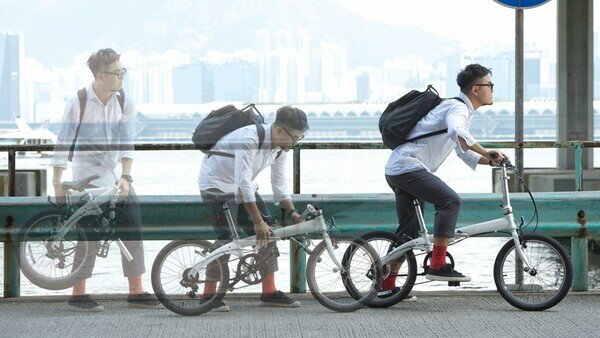In recent years, cycling has, in addition to being a well-loved outdoor activity, become a part of the busy daily lives of workforce in the city. Some will cycle their way to work instead of riding on public transport to keep fit and to practice green living.
Folding bicycles have come into fashion as they are easy to store, move, carry and are ideal for the cramped living environment in Hong Kong. The Consumer Council and International Consumer Research and Testing have jointly tested a number of folding bicycle models. On a 5-point scale, 1 out of the 6 samples obtained 3.5 points with the remaining 5 models scoring 4 or 4.5 points indicating that the overall rating of these samples are satisfactory. However, their assessments differ in details such as riding experience, operational performance, volume and weight and therefore cannot be treated lightly by consumers. In addition, the warranty period of these samples vary significantly from the longest of 10 years to the shortest of 3 years. Consumers should pay extra care in this aspect.
The test was conducted in Europe. Other than testing on construction and equipment, assessments by users were also added. Based on actual user experiences, the samples were compared in their riding, folding and unfolding, moving, parking and storage performances. Among them, 6 models are available in Hong Kong. Samples are priced from $2,780 to $12,820, including 4 models with gearshift and 2 fixed gear models.
The design of folding bicycles varies. The most common one is to fold at the hinge at the middle of the bicycle frame to shorten its length by nearly half. The front and saddle can also be bent down and adjusted downwards. Some have scissor-like designs that once unfolded, the crossbars can be locked together to form a triangle and when folded, turned into a pole. The handlebars of some models can be bent downwards. In a small numbers of models, the front wheel is only supported on single-side of a monoblade front fork, and some models are equipped with auxiliary small wheels. These design details can further reduce the volume of bicycles after folding, making them more compact and easier for consumers' storage and delivery.
Braking is the most basic and important function of bicycles. 1 sample uses rear coaster brake to replace the traditional one which makes the bicycle design more simplistic. Test result showed that the brake performance of this sample is average, and the stopping distance of the rear coaster brake sample is longer than other samples. 1 other sample has slightly shorter handlebars which will increase the steering difficulty. In addition, cyclists may feel leaning backward while riding which is not easy for every user to get accustomed to. Consumers are advised to look at the pros and cons of various designs by evaluating their ease of control, safety and other aspects.
In terms of folding and unfolding operation, most samples give good performance and can be folded within 4 to 5 steps. 1 sample, once folded, can rest on the ground stably for pushing along, and auxiliary small wheels facilitate movement and was awarded 5 points. Among the 6 samples, the heaviest weighs 13.8 kg (2 models), and the lightest weighs 10.6 kg with a difference of 3.2kg. Cyclists who need to carry their bicycles onto public transport should choose with extra care.
In view of Hong Kong's packed living space, the storage of bicycle is an important factor to consider before purchasing. The assessors measured the sample volume once folded to deduct the storage space required. There were also simulations having the samples put into car boot and travel on commuter trains similar to LRT. 1 sample with 16 inches wheel diameter scored 5 points and its volume after folding is also the smallest.
Over the past 4 years, there have been approximately 2,500 casualties in traffic accidents involving cyclists annually where 7 to 10 people died. According to data from American Association of Neurological Surgeons, the number of cyclists’ head trauma case is the highest among all sports. Cyclists should wear helmets that meet standards and are suitable while riding.
Despite the good performance test results, the cyclists riding attitude such as whether they have taken sufficient safety measures and if they obey the traffic rules is of utmost importance in ensuring their safety. The Council reminds consumers to pay attention to the following when riding bicycles:
- Bicycles must be equipped with reflectors and bells. During night or when visibility is low, the white headlight and red rear light must be switched on;
- While riding a bicycle, keep a safe distance between the bicycle and the vehicle ahead. Make good use of cycle tracks, if you wish to cross the pedestrian crossing, light rail or railways, you must get off the bicycle;
- Check the bicycle performance regularly, including whether braking systems and bell can operate normally, the inflation of tires and lubricate the moving parts of the bicycle from time to time;
- Always be alert to road conditions. While riding, do not use any audio headset, hold the handlebars at all times and have your feet on the pedals;
- In general, the rear brakes should be used. Use the front brake only when the front wheel is directed forward. To avoid using the wrong brake during emergency, you should familiarise yourself with the left and right brake levers and their corresponding brakes.
The Consumer Council reserves all its right (including copyright) in respect of CHOICE magazine and Online CHOICE.




